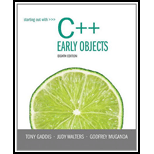
A) // This code should use a loop to raise a number to a power.
int num. bigNum, power, count;
cout << "Enter an integer: ";
cin >> num;
cout << "What power do you want it raised to? ";
cin >> power;
bigNum = num;
while (count++ < power);
bigNum *= num;
cout << "The result is << bigNum << endl;
B) // This code should average a set of numbers, int numCount, total;
double average;
cout << "How many numbers do you want to average? ";
cin >> numCount;
for (int count = 0; count < numCount; count++)
{
int num;
cout << "Enter a number: ";
cin >> num;
total += num;
count++;
}
average = total / numCount;
cout << "The average is << average << endl;
Want to see the full answer?
Check out a sample textbook solution
Chapter 5 Solutions
Starting Out with C++: Early Objects
Additional Engineering Textbook Solutions
Modern Database Management
Starting Out with C++ from Control Structures to Objects (9th Edition)
Starting Out with Programming Logic and Design (5th Edition) (What's New in Computer Science)
HEAT+MASS TRANSFER:FUND.+APPL.
Web Development and Design Foundations with HTML5 (8th Edition)
Starting Out with Java: From Control Structures through Objects (7th Edition) (What's New in Computer Science)
 EBK JAVA PROGRAMMINGComputer ScienceISBN:9781305480537Author:FARRELLPublisher:CENGAGE LEARNING - CONSIGNMENTProgramming Logic & Design ComprehensiveComputer ScienceISBN:9781337669405Author:FARRELLPublisher:Cengage
EBK JAVA PROGRAMMINGComputer ScienceISBN:9781305480537Author:FARRELLPublisher:CENGAGE LEARNING - CONSIGNMENTProgramming Logic & Design ComprehensiveComputer ScienceISBN:9781337669405Author:FARRELLPublisher:Cengage C++ Programming: From Problem Analysis to Program...Computer ScienceISBN:9781337102087Author:D. S. MalikPublisher:Cengage Learning
C++ Programming: From Problem Analysis to Program...Computer ScienceISBN:9781337102087Author:D. S. MalikPublisher:Cengage Learning Microsoft Visual C#Computer ScienceISBN:9781337102100Author:Joyce, Farrell.Publisher:Cengage Learning,
Microsoft Visual C#Computer ScienceISBN:9781337102100Author:Joyce, Farrell.Publisher:Cengage Learning, C++ for Engineers and ScientistsComputer ScienceISBN:9781133187844Author:Bronson, Gary J.Publisher:Course Technology Ptr
C++ for Engineers and ScientistsComputer ScienceISBN:9781133187844Author:Bronson, Gary J.Publisher:Course Technology Ptr EBK JAVA PROGRAMMINGComputer ScienceISBN:9781337671385Author:FARRELLPublisher:CENGAGE LEARNING - CONSIGNMENT
EBK JAVA PROGRAMMINGComputer ScienceISBN:9781337671385Author:FARRELLPublisher:CENGAGE LEARNING - CONSIGNMENT





